Input interpretation

undecane
Chemical names and formulas

formula | CH_3(CH_2)_9CH_3 Hill formula | C_11H_24 name | undecane alternate names | hendecane | hendecane (undecane) | hendekan | N-undecane mass fractions | C (carbon) 84.5% | H (hydrogen) 15.5%
Lewis structure

Draw the Lewis structure of undecane. Start by drawing the overall structure of the molecule: Count the total valence electrons of the carbon (n_C, val = 4) and hydrogen (n_H, val = 1) atoms: 11 n_C, val + 24 n_H, val = 68 Calculate the number of electrons needed to completely fill the valence shells for carbon (n_C, full = 8) and hydrogen (n_H, full = 2): 11 n_C, full + 24 n_H, full = 136 Subtracting these two numbers shows that 136 - 68 = 68 bonding electrons are needed. Each bond has two electrons, so the above diagram has all the necessary bonds. There are 34 bonds and hence 68 bonding electrons in the diagram. Lastly, fill in the remaining unbonded electrons on each atom. In total, there remain 68 - 68 = 0 electrons left to draw and the diagram is complete: Answer: | |
3D structure
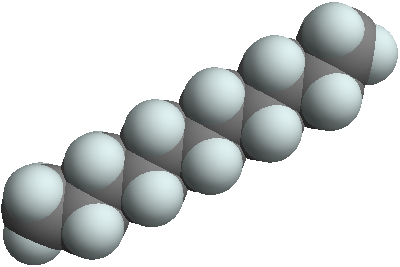
3D structure
Basic properties
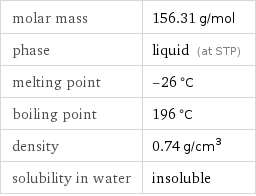
molar mass | 156.31 g/mol phase | liquid (at STP) melting point | -26 °C boiling point | 196 °C density | 0.74 g/cm^3 solubility in water | insoluble
Units

Liquid properties (at STP)
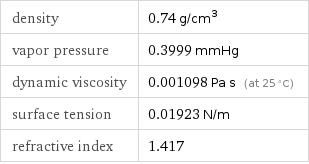
density | 0.74 g/cm^3 vapor pressure | 0.3999 mmHg dynamic viscosity | 0.001098 Pa s (at 25 °C) surface tension | 0.01923 N/m refractive index | 1.417
Units

Thermodynamic properties

molar heat of vaporization | 41.5 kJ/mol specific heat of vaporization | 0.265 kJ/g molar heat of combustion | 7437 kJ/mol specific heat of combustion | 47.58 kJ/g molar heat of fusion | 22.2 kJ/mol specific heat of fusion | 0.142 kJ/g thermal conductivity | 0.1326 W/(m K) critical temperature | 5217 K critical pressure | 453.189 MPa (at STP)
Chemical identifiers

CAS number | 1120-21-4 Beilstein number | 1697099 PubChem CID number | 14257 PubChem SID number | 24900644 SMILES identifier | CCCCCCCCCCC InChI identifier | InChI=1/C11H24/c1-3-5-7-9-11-10-8-6-4-2/h3-11H2, 1-2H3 RTECS number | YQ1525000 MDL number | MFCD00008959
NFPA label

NFPA label
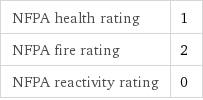
NFPA health rating | 1 NFPA fire rating | 2 NFPA reactivity rating | 0
Safety properties
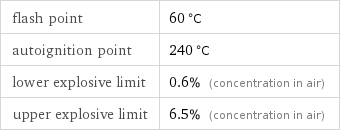
flash point | 60 °C autoignition point | 240 °C lower explosive limit | 0.6% (concentration in air) upper explosive limit | 6.5% (concentration in air)

DOT hazard class | 3 DOT numbers | 2330